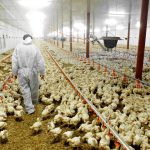
Simple changes in conventional farming practices, particularly those that repair soil, could be the key to feeding the world
Saturday, September 29, 2018 by Isabelle Z.
http://www.realsciencenews.com/2018-09-29-simple-changes-in-conventional-farming-practices-feeding-the-world.html

Not surprisingly, the promises that GMOs would save the world from hunger have failed to materialize. In addition to failing to make inroads in this serious issue, they’re also causing a slew of health and environmental problems. It’s clear that a different approach is needed, and it looks like one of the simplest solutions could end up being one of the best.
According to experts like University of Washington Geomorphology Professor David R. Montgomery, the answer to how to feed the world lies in reversing the soil degradation that is responsible for taking roughly a third of our planet’s farmland out of production.
Professor Montgomery points out that agrochemicals and mechanization might have initially boosted crop yields, but the one-two punch of heavy fertilizer and mechanical tillage has left soil organic matter in disrepair. Farms in the U.S. have lost around half of the soil organic matter they had in colonial days, and the problem is only likely to get worse once the cheap oil fueling chemical fertilizer production runs out. On a six-month journey throughout the nation, Montgomery found that the rich black topsoil in many areas has virtually disappeared, forcing farmers to try to make the most of “anemic” subsoil. He saw similar trends in Latin America and Africa.
All hope is not lost, however; he believes that regenerative agriculture could help rebuild fertility on degraded farmland quickly, as well as profitably. Best of all, it can do this without reducing crop yields. First, he thinks plowing should be given up altogether so the soil won’t be disturbed. Planting cover crops can help protect from ground corrosion while building up soil organic matter. When it comes to pests and pathogens, he suggests adopting crop rotation patterns. Some farmers have already successfully reintroduced livestock to take care of grazing cover crops and manuring fields.
Those farmers who have used these practices are finding a reduced need and expense when it comes to chemical inputs, while their soil quality is also turning around. In fact, after just a few years, many farmers’ harvests have returned to past levels or even surpassed them. Agrochemicals are a huge expense that many conventional farmers are happy to get rid of, but even organic farms can benefit financially from reducing their need for diesel to run machinery.
This approach also has the effect of raising the amount of carbon that the soil retains. If adopted on a wider scale, he believes the practice could make a big impact on fossil fuel emissions. It would also benefit the environment in other ways, such as by reducing the nitrate pollution found in groundwater and other bodies of water and by improving drought resilience thanks to better moisture retention and more efficient use of water.
How can we encourage farmers to get on board?
Many farmers say they believe these practices would be used more widely if the conventional practices that are causing soil degradation were not subsidized by the government. Rewarding farmers for switching to regenerative practices instead could make a huge difference. In addition, efforts could be made to evaluate the right regenerative methods for various geographic regions. Meanwhile, conservation agricultural practices could become a prerequisite for getting subsidized crop insurance.
Montgomery and the many farmers he spoke to aren’t the only ones who see the need for new, soil-friendly approaches. A report recently published by the European Academies Science Advisory Council urged policy makers to take action on soil sustainability. They point out the important roles that soils play in regulating the planet’s climate, preserving biodiversity, and sustaining agriculture.
The researchers called on the EU as well as local authorities and national agencies to institute policies supporting soil awareness and education. More and more experts believe that this approach could well be the key to feeding the world.
Sources for this article include:
Tagged Under: Tags: agriculture, agrochemicals, Big AG, biodiversity, Ecology, ecosystem, environment, farmland, feed the world, food supply, organic farming, soil, soil awareness, soil degradation, soil health, soil organic matter, sustainability, world hunger





